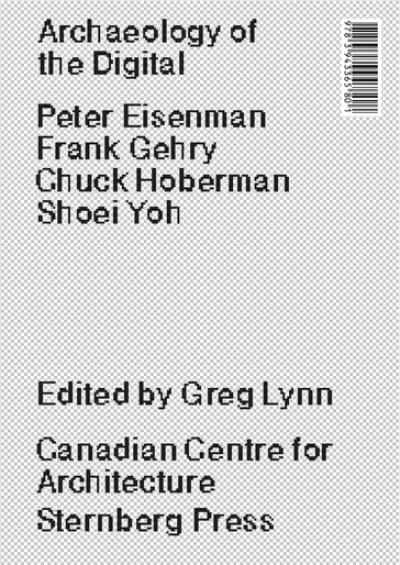
Archaeology of the Digital
With text by and interviews with Peter Eisenman, Frank Gehry, Benjamin Gianni, Chuck Hoberman, Greg Lynn, Kenshi Oda, Bill Record, Rick Smith, Tensho Takemori, Joe Tanney, Chris Yessios, Shoei Yoh, Mirko Zardini
Archaeology of the Digital delves into the genesis and establishment of digital tools for design conceptualization, visualization, and production at the end of the 1980s and the beginning of the 1990s. Conceived as an object-based investigation of four pivotal projects that established distinct directions in architecture’s use of digital tools, the book highlights the dialogue between computer sciences, architecture and engineering that was at the core of these experiments.
The Lewis Residence by Frank Gehry (1989–95) was prescient in exploring the power of computer rationalization in describing and fabricating sculptural tectonic elements. On the other hand, Peter Eisenman’s Biozentrum (1987) tested the computer’s ability to generate its own formal language. A vanguard attempt to digitally script the design process, the Biozentrum’s geometries emerge from abstract representations of DNA structures, manipulated through processes intended to simulate genome replication. The scaffold-like lines of Shoei Yoh’s unbuilt Odawara Municipal Sports Complex (1990–91) wood truss ceiling and constructed gymnasium Galaxy Toyama (1990–92) were verified for integrity by computer analysis, using intensive coding and virtual testing to advance a language of minimalist structural expressionism. Chuck Hoberman’s Expanding Sphere (1992) is a finely-tuned folding polyhedron that smoothly expands and contracts, opening the way to later explorations in responsive and adaptive architecture.
This volume includes conversations with the architects and key collaborators in each of the featured projects—architects, engineers, software programmers and university researchers whose interests in these nascent technologies were evident in their own practices. Each project is then presented through a selection of archival material, conveying factual and concrete information on their development through this material history.
Copublished with the Canadian Centre for Architecture
Design by Katja Gretzinger








